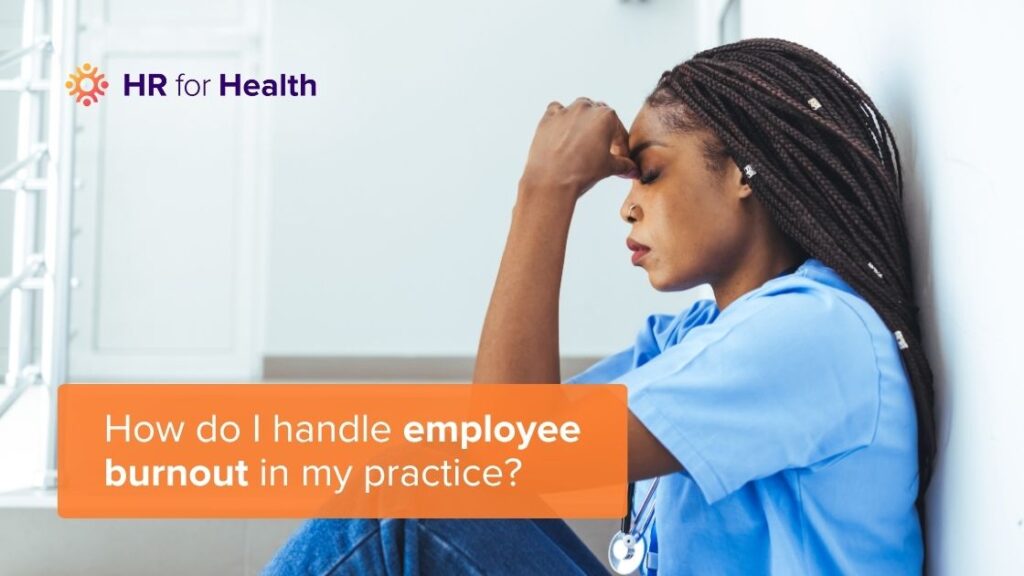Employee burnout has reached critical levels across healthcare settings, creating unprecedented challenges for practices struggling to maintain quality patient care while supporting their valuable staff members. The demanding nature of healthcare work, combined with recent industry pressures, has intensified stress levels and contributed to widespread healthcare employee burnout that affects everything from patient outcomes to practice profitability.
At HR for Health, we streamline HR processes like payroll, PTO, time tracking, and compliance documentation to give practice owners and office managers back valuable time. While we don’t provide direct burnout interventions, our goal is to help reduce the administrative burdens that often contribute to staff dissatisfaction and give you the capacity to focus on the people-first aspects of team care.
Understanding Healthcare Employee Burnout
Employee burnout in healthcare represents more than temporary stress or occasional fatigue. It is recognized by the World Health Organization as an occupational phenomenon, rather than a medical condition, with psychological and organizational impacts. It is commonly described as involving three distinct components that can significantly affect both individual wellbeing and team performance.
- Emotional exhaustion: Feeling drained, overwhelmed, and unable to meet the constant emotional demands of patient care.
- Depersonalization: A sense of emotional detachment and cynicism toward patients, where individuals may begin to feel disconnected from the purpose or meaning of their work.
- Reduced personal accomplishment: A feeling of ineffectiveness or a sense that one’s work lacks value or success.
The Cost of Burnout in Healthcare Settings
Burnout in healthcare carries substantial financial and operational costs beyond individual employee wellbeing concerns. According to the American Medical Association, burnout-related turnover costs healthcare organizations between $500,000 and $1 million per departing physician, with similar substantial costs for nursing and other healthcare professional turnover.
Increased absenteeism represents another significant cost factor. Burned-out employees use more sick leave, require more mental health days, and often work at reduced capacity even when present. This “presenteeism” can be more costly than absenteeism because it affects quality of care while still requiring full compensation.
Patient safety suffers when healthcare workers experience burnout. Studies consistently show correlations between burnout levels and increased medical errors, patient complaints, and malpractice claims. The emotional exhaustion and reduced concentration associated with burnout directly impact clinical decision-making and attention to detail that patient safety requires.
Healthcare workplace stress also affects recruitment efforts. Practices with high burnout rates develop reputations that make attracting quality candidates increasingly difficult. Word spreads quickly in healthcare communities about workplaces that don’t support employee wellbeing, creating competitive disadvantages in tight labor markets.
Some of the frustrations that drive burnout like manual scheduling, inconsistent PTO policies, and payroll issues often stem from administrative inefficiencies. HR for Health automates those processes so leaders can prioritize well-being initiatives over paperwork.
Identifying Early Warning Signs of Burnout
Early identification of burnout symptoms enables intervention before conditions worsen and become more difficult to address. Physical signs often appear first, including chronic fatigue that doesn’t improve with rest, frequent headaches, gastrointestinal problems, and sleep disturbances that affect both falling asleep and staying asleep.
Emotional indicators include increased irritability, anxiety about work situations, feelings of dread about going to work, and depression that seems connected to job responsibilities. Healthcare workers may also experience emotional numbness, finding it difficult to connect with patients or feel satisfaction from work achievements.
Behavioral changes become apparent to colleagues and supervisors who know the employee well. Previously punctual employees may start arriving late or calling in sick more frequently. Engaged workers might become withdrawn during team meetings or social interactions. Some individuals turn to alcohol, drugs, or other unhealthy coping mechanisms to manage work-related stress.
Performance indicators often provide the clearest evidence of developing burnout. Increased patient complaints, missed deadlines, documentation errors, or conflicts with colleagues may signal that an otherwise competent employee is struggling with burnout-related challenges.
Our platform can help make these indicators more visible. For example, built-in PTO tracking and automated reminders make it easier to identify under-used time off or frequent last-minute absences which can often be early flags for burnout.
Team and Practice-Level Indicators
Workplace burnout often affects entire teams rather than isolated individuals, creating organizational symptoms that require systematic responses. High turnover rates, particularly among experienced staff members who have previously been satisfied with their positions, often indicate widespread burnout issues.
Key organizational warning signs include:
- Increased sick leave usage across multiple departments or employee classifications
- Rising patient complaints about staff attitude, responsiveness, or communication
- Frequent conflicts between team members who previously worked well together
- Declining performance metrics in areas like patient satisfaction, productivity, or quality measures
- General atmosphere changes where negativity, cynicism, or resignation become prevalent
- Higher error rates in documentation, medication administration, or other critical tasks
Prevention Strategies for Healthcare Burnout
Essential healthcare burnout prevention strategies that practices should implement immediately include:
- Establish realistic workload expectations based on patient acuity and staff capabilities rather than arbitrary productivity targets
- Implement flexible scheduling options that accommodate personal needs while maintaining adequate coverage
- Create peer support programs that connect experienced staff with newer employees for mentorship and guidance
- Provide regular mental health resources including employee assistance programs and stress management workshops
- Develop clear communication channels that allow staff to voice concerns without fear of retaliation
- Invest in technology and equipment that reduces repetitive tasks and eliminates HR bottlenecks. Platforms like HR for Health simplify time tracking, automate performance review cycles, and help maintain clear, accessible policies – making it easier to create a stable, transparent workplace culture.
- Establish recognition programs that acknowledge both individual achievements and team accomplishments
- Offer professional development opportunities that help staff advance their careers and maintain engagement
Recovery and Support Strategies
When healthcare workers are already experiencing burnout recovery challenges, practices must provide comprehensive support that addresses both immediate needs and long-term rehabilitation. Employee assistance programs offer confidential counseling services, mental health resources, and referrals to specialized treatment when needed.
Modified work arrangements can provide relief while employees recover from burnout. Temporary schedule adjustments, reduced patient loads, or assignment to less stressful duties allow healing while maintaining employment connections and income stability.
Return-to-work protocols should be gradual and supportive, recognizing that burnout recovery takes time and may involve setbacks. Rushing employees back to full responsibilities before they’re ready often leads to relapse and potentially permanent departure from healthcare careers.
The Role of Leadership in Burnout Prevention
Healthcare practice leaders play crucial roles in creating workplace mental health cultures that either prevent or contribute to burnout development. Leaders who model healthy work-life balance behaviors demonstrate that self-care is valued and expected rather than seen as weakness or lack of commitment.
Regular feedback and recognition help healthcare workers understand that their contributions are valued and making meaningful differences in patient outcomes. Simple acknowledgment of good work, patient compliments, or successful outcomes can provide the positive reinforcement that counteracts burnout development.
Effective employee handbook policies should clearly outline mental health resources, burnout prevention strategies, and support available to struggling employees. A well-maintained employee handbook with clear, up-to-date policies also builds confidence and clarity. HR for Health provides legally compliant federal, state, and local handbooks and automatic updates so your documentation always supports your team.
Building Resilient Healthcare Teams
Long-term staff retention strategies focus on building teams that can withstand healthcare stressors while maintaining high performance and job satisfaction. Resilient teams support each other during difficult situations, share knowledge and expertise, and maintain positive cultures even during challenging periods.
Team building activities that aren’t forced or superficial help build genuine connections between colleagues. Shared experiences, problem-solving exercises, and regular team meetings that focus on both work issues and team dynamics strengthen relationships that provide support during stressful periods.
Cross-training initiatives help teams maintain coverage when members need time off for recovery or personal needs. Teams that can flex and adapt to changing staffing needs experience less stress when unexpected absences occur.
Contact HR for Health To Minimize the Impact of Burnout on Your Workplace
HR for Health helps healthcare practices streamline HR tasks so they can spend less time on paperwork and more time supporting their teams. From automating time-off tracking to simplifying performance reviews, we help reduce the hidden stressors that contribute to burnout and give you more capacity to care for your staff. Contact us today to learn about how HR automation can help you support your people better.


